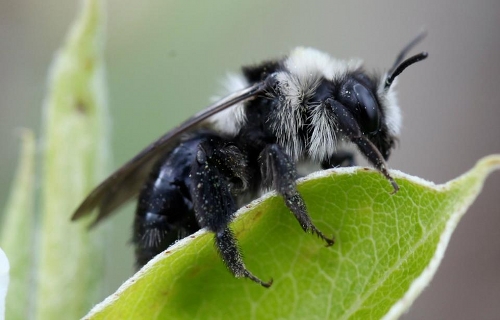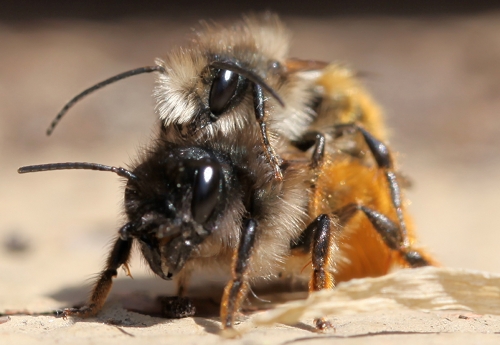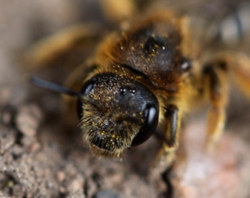by Brigit Strawbridge
Brigit is a writer, environmental activist and a passionate campaigner for the protection of bees. She gives inspiring talks around the country opening a window to the world of bees, educating about the devastating decline in their population and the ways we can help them. Learn more about Brigit’s work and how you can book her for a talk here: beestrawbridge.blogspot.com

Andrena cineraria female (Ashy Mining solitary bee) sitting on a pear tree leaf. Photo credit: Brigit Strawbridge
I’ve just returned home from a lovely long walk in the woods on the lower slopes of the Malvern Hills. I walk these woods as often as I can and always take my camera with me. I can pretty much guarantee – from March through till mid September – that the understory, clearings and edges will be ‘abuzz’ with numerous species of bumblebees, honeybees and (on sunny days) solitary bees as they enjoy the foraging and nesting opportunities afforded by this wonderful diverse habitat.
I’m absolutely fascinated by bees; from the different frequencies at which they buzz, their purpose in life and the challenges I face trying to identify them – to their life cycles, their behavioural traits and the myriad relationships they have built up over the millennia with flowering plants. I cannot imagine what the world would be like without bees. In fact a World without bees is, quite simply, unimaginable.
Bees as Pollinators
The unique relationship between pollinators and flowering plants has been evolving for over 100 million years and there are currently estimated to be around 200,000 different species of animal worldwide acting as pollinators. These include beetles, bats, flies, wasps, birds, butterflies, moths and some mammals; but it is without doubt the humble bee that does the lion’s share of the work.
From a ‘human-centric’ point of view, bees are responsible for pollinating around a third of the food we eat (this includes meat from animals that graze on bee-pollinated clover and alfalfa) – as well as many of the crops we grow for drinks, medicines and textiles. However, bees are important for more reasons than the fact that they pollinate food for human consumption……….
Bees also pollinate over 80% of the world’s wild flowers and, interestingly, whilst great attention is always given to the bee’s role as our main crop pollinator, we would do well to note that they play an equally important role as ‘keystone species’ in the planet’s eco-systems. I’ll come back to this in a moment.
BEE DECLINE
There has been a great deal of coverage in the media over the last decade about the Decline of the Honeybee, whose value to the ‘economy’ has been estimated at many £££billions.
But, apart from the fact that honeybees should be valued for more than just their economic worth, it is important to note that:
a) it is not just honeybees that are in decline
b) honeybees are not our only pollinators. In fact, of the 100 or so crops that feed and clothe the world, only 15% are serviced by domestic honeybees – whilst over 80% are serviced by native wild bees and other wild pollinators.
N.B: By no means am I suggesting that any one species of bee is more important than another. They all have different roles to play and are active at different times of the year/day. Without honeybees there would be very little pollinating going on early in the year and we would have no lemons, without bumblebees out tomato and blueberry crops would struggle and without solitary bees our apple trees would suffer.
Here’s a very interesting list of ‘who pollinates what’ – List of plants pollinated by bees
Setting aside, for a moment, their importance as pollinators of food, medicine and textile crops for humans, I‘d like to come back now to the fact that bees are ‘keystone’ species – playing absolutely crucial roles in sustaining many of the world’s eco-systems.
If you remove a keystone species from any given eco-system, you risk at the very least a great reduction in the biodiversity of that community – and at worst it’s complete collapse.
Eco-systems are incredibly complex; each made up of numerous, diverse, dynamic, interconnected communities.
We cannot keep removing the building blocks that hold these systems together and expect them to survive.
By compromising the earth’s eco-systems we compromise all life on Earth, including, ultimately, our own. Our lack of joined-up thinking and our blinkered human-centric behaviour are, ironically, leading us to neglect and destroy the very systems that nurture and sustain us. I cannot over emphasis the importance of the role bees and other pollinators play in supporting and maintaining the fragile balance that allows ‘life as we know it’ to exist on planet Earth.
There are over 25,000 species of bee in the world and around 250 of these species live in the British Isles. British species include the European Honeybee, 24 species of Bumblebee and over 230 different species of Solitary Bee. All are suffering from the effects of intensive agriculture, pesticides poisoning and urban sprawl, which, together, have led to the fragmentation, degradation, and loss of their once rich and diverse habitat. Add to these factors the effects of climate change (which has caused significant problems for bees this year) and a rise in disease and pests – and it’s no wonder our poor beleaguered bee population is on the brink.
(N.B. As well as the alarming decline in honeybee populations, 3 of our bumblebee species have disappeared over the last 50 years, many more bumblebees and solitary bees are severely threatened and there are currently 7 bumblebees and 10 solitary bees on the UK Biodiversity Action Plan (BAP) priority list.)
To halt this decline we need to take action NOW.
Talking, debating, spending millions of £££s on further research to tell us what is already glaringly obvious, writing reports and holding summits on the other side of the world are all very well, but without immediate ACTION these are a complete waste of time.
So what has all this got to do with trees and woodlands…..?
From the trees point of view, most are wind pollinated so they could survive without bees. There are exceptions however; including fruit bearing trees such as apple, pear, cherry and almond which all rely (some exclusively) on bees for pollination.
The importance of trees for bees is, however, an entirely different matter. The fact that most trees are wind pollinated doesn’t preclude them from being incredibly rich food sources for bees and other pollinators – in fact certain species of trees provide an absolutely vital source of pollen and nectar for early spring foraging bees.
Honeybees store sufficient honey to feed the colony through the winter, but need to replenish their stocks by early spring. There is very little around in the way of flowering plants during the first few months of the year, so the early flowering willows, especially goat willow, provide them with a lifeline. Willow is also a vital food source for early rising bumblebee queens when they emerge from hibernation. Just walk along any riverbank on a sunny February/March day and you will easily locate the willows with your eyes closed by the sound of bees buzzing in the branches above your head.
Deforestation has been occurring in the British Isles since the arrival of Neolithic man and has reached the stage where, today, less than 12% of the UK is still wooded. Crucially, less than half this area is planted with native trees (the rest being planted with non-native conifers) – and only 2% of our original ancient woodlands remain.
Add these figures to the fact that we have also lost 98% of our wildflower meadows and grasslands since the 1940s… and it is no wonder our pollinators are in trouble.
Habitat decline has impacted enormously upon our once diverse wildlife and we simply cannot afford further losses….of habitat or species. So many species of bees and other insects, not to mention small mammals, amphibians and birds, are now teetering on the brink – and what remains of our ancient and native woodlands provides an absolutely vital source of habitat and forage for many of these remaining species and populations.
Whilst the media and the ‘powers that be’ continue to bang on endlessly about the economy, time is gradually ticking away. For every single moment that their focus remains on the perceived importance of rebuilding the economy rather than addressing the very real importance of the imminent breakdown of our eco-systems, we are coming closer and closer to a sixth major extinction scenario. It really is quite bizzare that these seemingly intelligent people are so blind to this fact!
We need to address both issues of ‘habitat loss’ and ‘pesticides’ (which I haven’t gone into in this article but have written about in detail here) urgently and simultaneously.
What can we do to help?
Whoever you are and whatever your circumstances and skill sets will determine the part you have to play in helping to halt the decline of biodiversity. You may like to plant more trees, hedgerows and/or flowers; write to your MP about these issues; join a local wildlife group; support the amazing SAVE OUR WOODS campaign; stop using pesticides; ask your local garden centre to stop selling pesticides containing neonicotinoids or send a link to this article to a friend!
Anything you do is better than doing nothing. Doing nothing is not a good option.
N.B. Do please check out this site, packed with stunningly beautiful photographs, to find out more about the amazing world of Woodland & Hedgerow Bees
TREES FOR BEES
Willow (NP) Pear (P) Apple (NP) Cherry (NP), Crab Apple (NP) Medlar (NP) Quince (NP) Sweet Chestnut (NP), Acacia (NP), Field Maple (NP) Mountain Ash (NP), Alder (P) Blackthorn (NP), Horse chestnut (NP), Hawthorn (NP), Crab apple, Lime (N), Whitebeam (NP), Sycamore (NP) Hazel (P) Holly (NP) Bramble (NP)
* N = nectar; P= pollen
Excellent website for wildlife gardening
Thank you for reading this.
Much love,
Brigit x
This article was originally posted on Brigit’s blog: beestrawbridge.blogspot.co.uk































Absolutely love this article. Thank you for showing the important relationship between bees and trees. A great and accurate introduction to the sometimes confusing bee group. Just a small error on one of the photo captions. The White-tailed bumblebee is Bombus lucorum. The Buff-tailed bumblebee is Bombus terrestris. The workers of these two species overlap such that from the photo alone it would be impossible to distinguish between these two species.
Dear Elaine,
Thank you so much for your helpful comment! How do you tell the difference between the terrestris and the lucorum?
The photo of the white tailed bumble bee I took in the willow that grows in our hedgerows here on Exmoor. I call them Bumble trees they’re so full of bees! The first time I witnessed it I thought there was a swarm somewhere but no, just lots and lots of bees feeding.
Not so many this year though. Hope next year the trees are buzzing again!
Hen
Hello Hen
the queens and males are easier to tell apart. Buff-tailed queens and males have a buff-coloured tail (anything from orangey brown to beige). This yellow bands in this species is much darker/golden than the brighter lemon yellow bands of the white-tailed bumblebee. Although workers of both species have white tails, buff-tailed workers can have a buff edge at the top of the tail, which if seen is diagnostic of this species.
See this web page for more info
http://bumblebeeconservation.org/about-bees/identification/
Absolutely wonderful.
Beautiful blog – thank you – am planting as many wild flowers and fruit trees as I can fit in my little suburban garden – have also added wild plum, blackthorn, hazel and willow to my privet hedge.
One other plant (I am sure there are many) that is wonderful for bees – the Cotoneaster – wasn’t my favourite shrub (it goes a bit leggy) and I wouldn’t have chosen it, however, we inherited when we bought the house – and by golly the bees love the flowers in early spring – while the birds love the berries in late winter.
Best wishes
Huw
@HuwSayer
Doing some research on wild bees, so this is great. Thanks
The apple orchard opposite me (55 acres) is about to be grubbed to be replaced with a solar farm. Whilst not a traditional orchard some of the trees are 40 years old. Much has been made of how biodiversity will be improved but I find it hard to understand how the removal of 12,000 apple trees can help our struggling bee population. Would love your comments. Thanks